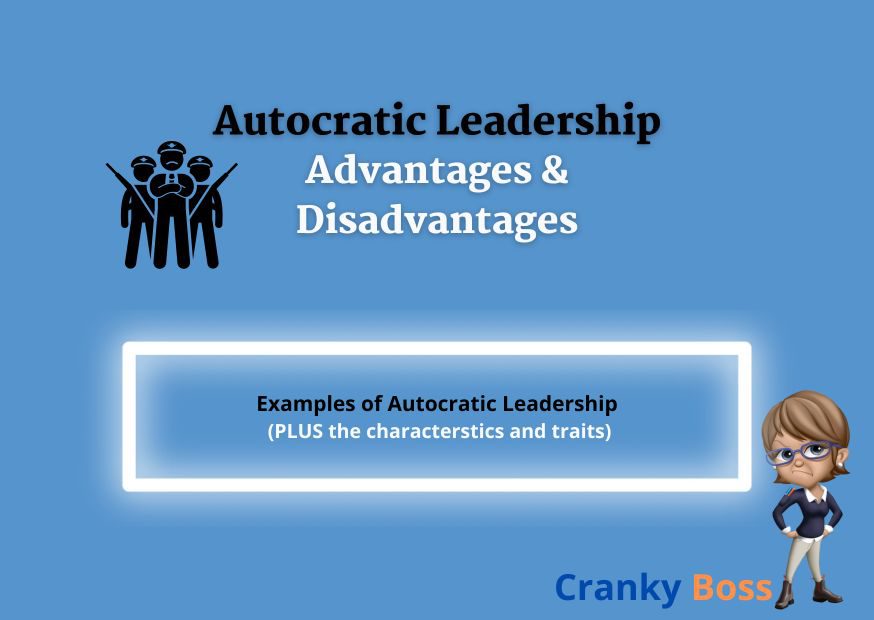Leadership styles play a crucial role in shaping organizational culture and driving team performance. Among the various leadership styles, autocratic leadership stands out for its authoritative approach and centralized decision-making. Let’s take a look at its defining characteristics, advantages, and disadvantages. By understanding the dynamics of autocratic leadership, leaders and managers can make informed decisions about when and how to employ this style effectively within their organizations.
What is Autocratic Leadership?
Autocratic leadership is a style of leadership where one person, typically the leader or manager, holds significant power and authority over decision-making and the direction of a group, team, or organization. In this leadership style, the leader has full control and makes decisions without seeking input or consensus from others. Unlike other leadership styles like delegative leadership, they often dictate tasks, set goals, and enforce rules and procedures without much room for discussion or feedback from team members.

Autocratic leaders tend to have a clear vision of what they want to accomplish and prefer to direct others in achieving those goals rather than involving them in the decision-making process. They may use their authority to enforce strict discipline and ensure that tasks are completed according to their instructions.
When is Autocratic Leadership Suitable?
While autocratic leadership can lead to quick decisions and efficient execution of tasks, it can also result in limited creativity, low morale among team members, and a lack of empowerment. This leadership style is most effective in situations where quick decision-making is necessary, such as during emergencies or when dealing with strict deadlines. However, it may not be well-suited for fostering collaboration, innovation, and employee engagement over the long term. It is the difference between being a boss and a leader.
Example of Autocratic Leadership
An example of autocratic leadership can be seen in a military setting, where a commanding officer holds authoritative control over the soldiers under their command. In this scenario, the commanding officer makes decisions regarding mission objectives, strategies, and tactics without consulting the soldiers. They also set the pace and use pacesetting leadership to ensure they are able to operate under intense pressure. This is critical to their objectives. The soldiers are expected to follow orders without question, and disobedience is met with strict consequences.
Another example can be found in some traditional family-owned businesses, where the founder or CEO maintains absolute control over all aspects of the company. They make decisions independently, without input from other employees, and expect strict adherence to their directives from subordinates.
In both instances, the leader exercises unilateral authority, making decisions independently and expecting obedience from those under their leadership. On the contrary a charismatic leader for example uses their charm to inspire and energize their following. While autocratic leadership can be effective in certain situations where quick decision-making and centralized control are necessary, it can also lead to feelings of resentment, lack of innovation, and decreased morale among team members over time.
Characteristics of Autocratic Leadership
Autocratic leadership is characterized by several key traits:
- Centralized Authority: The leader holds significant power and authority, often making decisions independently without consulting others.
- Directive Leadership Style: Autocratic leaders tend to provide clear instructions and expect strict adherence to their directives from subordinates.
- Limited Participation: There is minimal involvement of team members in the decision-making process. The leader typically makes decisions without seeking input or feedback from others. Employees will quickly feel demotivated and the workplace may become unproductive.
- Quick Decision-Making: Autocratic leaders prioritize efficiency and quick decision-making. They are able to make decisions swiftly due to their unilateral authority.
- Clear Hierarchical Structure: There is a clear chain of command, with the leader at the top of the hierarchy. Subordinates are expected to follow orders without question.
- Strict Control: Autocratic leaders often exercise strict control over tasks, processes, and outcomes. They may closely monitor, micromanage and supervise the work of subordinates to ensure compliance with their directives.
- Limited Empowerment: Subordinates may have limited autonomy and empowerment, as decision-making authority is concentrated in the hands of the leader.
- Emphasis on Results: Autocratic leaders typically prioritize achieving results and meeting objectives over fostering collaboration or employee satisfaction.
- Authoritarian Communication: Communication tends to be top-down, with the leader conveying instructions and expectations to subordinates in a directive manner.
- Less Emphasis on Relationship Building: Autocratic leaders may prioritize task accomplishment over building strong interpersonal relationships with team members.
These characteristics distinguish autocratic leadership from other leadership styles and contribute to its efficiency in certain contexts but can also lead to challenges such as decreased employee morale and innovation.
Advantages and disadvantages of autocratic leadership:
Advantages of Autocratic Leadership:
- Clear Direction: Autocratic leaders make decisions quickly and provide clear direction to their team members, reducing confusion and ambiguity.
- Efficiency: With a single decision-maker, tasks and projects can be executed swiftly without delays caused by consensus-building.
- Maintaining Order: In situations requiring immediate action or during emergencies, autocratic leadership can ensure quick responses and maintain order.
- Expertise Utilization: Autocratic leaders often possess specialized knowledge or expertise, allowing them to make informed decisions beneficial for the team or organization.
- Accountability: Since the leader holds full responsibility for decisions, it’s easier to trace accountability in case of success or failure.
Disadvantages of Autocratic Leadership:
- Limited Creativity: Team members may feel discouraged from sharing innovative ideas or solutions due to the top-down decision-making approach.
- Low Morale: Continuous control and lack of involvement in decision-making can lead to decreased motivation and morale among team members.
- Dependency: Over-reliance on the leader for decisions can hinder the development of critical thinking and problem-solving skills among team members.
- Resentment and Resistance: Autocratic leadership can breed resentment and resistance among team members who feel oppressed or undervalued.
- High Turnover: The authoritarian nature of this leadership style may result in higher turnover rates as employees seek environments with more participative decision-making processes.
Summing Up
In summary, while autocratic leadership can lead to quick decision-making and clear direction, unlike affiliative leadership, it may stifle creativity, lower morale, and foster dependency among team members. Balancing the benefits and drawbacks is essential in determining the most suitable leadership style for any given situation.

